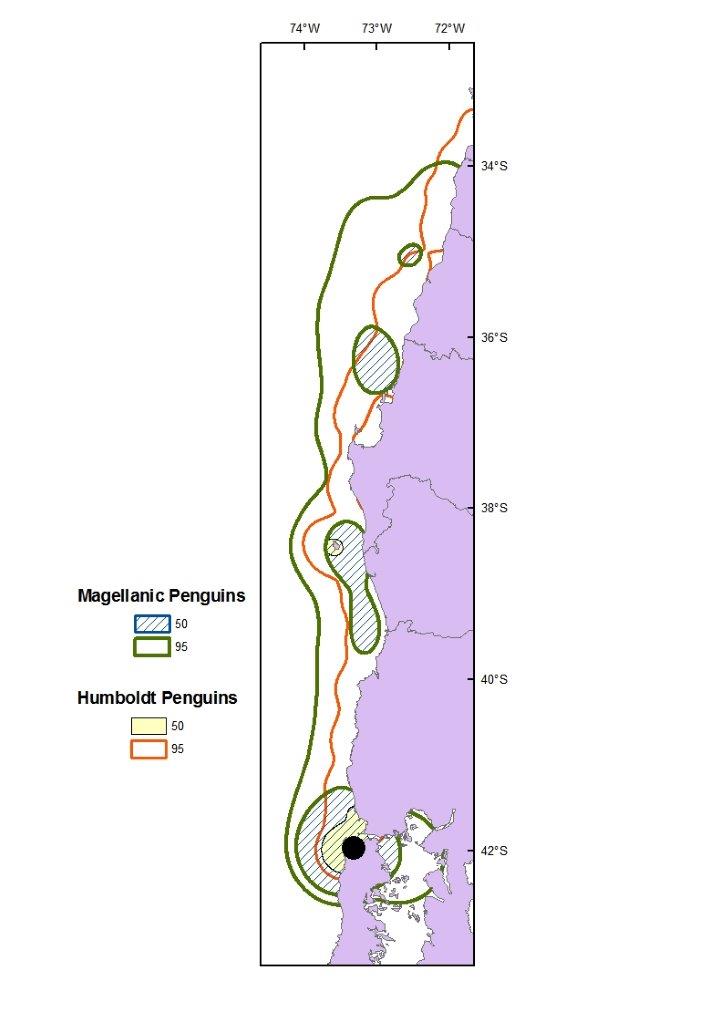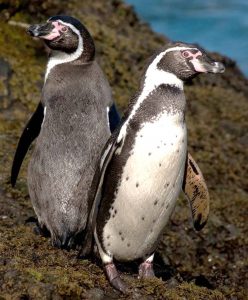
Verteilung von Humoldt- und Magellanpinguinen von Punihuil im Winter
 Die Bestände der Humboldtpinguine an der Westküste Südamerikas schwanken stark in Abhängigkeit vom El Niño/La Niña-Phänomen. Auf den Islotas Puñihuil überlappen sich die Verbreitungsgebiete von Humboldt- (südl. Verbreitungsgrenze) und Magellanpinguinen (nördl. Verbreitungsgrenze)(1,2,3). Die Ernährungsökologie während der Brutzeit (4) und das Migrationsverhalten während des Winters wurden daher vergleichend untersucht (5). Dabei stellte sich heraus, dass sich die Pinguine, unabhängig von Art und Geschlecht, in einem Küstenstreifen bewegten, der von der Brutkolonie etwa 1000 km nach Norden bis etwa auf die Breite von Santiago reichte.
Die Bestände der Humboldtpinguine an der Westküste Südamerikas schwanken stark in Abhängigkeit vom El Niño/La Niña-Phänomen. Auf den Islotas Puñihuil überlappen sich die Verbreitungsgebiete von Humboldt- (südl. Verbreitungsgrenze) und Magellanpinguinen (nördl. Verbreitungsgrenze)(1,2,3). Die Ernährungsökologie während der Brutzeit (4) und das Migrationsverhalten während des Winters wurden daher vergleichend untersucht (5). Dabei stellte sich heraus, dass sich die Pinguine, unabhängig von Art und Geschlecht, in einem Küstenstreifen bewegten, der von der Brutkolonie etwa 1000 km nach Norden bis etwa auf die Breite von Santiago reichte.
- (1) Hiriart-Bertrand, L., A. Simeone, R. Reyes-Arriagada, V. Riquelme, K. Pütz & B. Lüthi (2010) Description of a mixed-species colony of Humboldt (Spheniscus humboldti) and Magallanic Penguins (S. magellanicus) at Metalqui Island, Chiloé, southern Chile. Boletín Chileno de Ornitologia 16(1): 42-47
- (2) Reyes-Arriagada, R., L. Hiriart-Bertrand, V. Riquelme, A. Simeone, K. Pütz, B. Lüthi and A. Raya Rey (2013) Population trends of a mixed-species colony of Humboldt and Magellanic Penguins in southern Chile after establishing a Protected Area. Avian Conservation and Ecology 8 (2): 13
- (3) Simeone, A., L. Hiriart-Betrand, R. Reyes-Arriagada, M. Halpern, J. Dubach, R. Wallace, K. Pütz & B. Lüthi (2009) Heterospecific pairing and hybridization between wild Humboldt and Magellanic Penguins in southern Chile. Condor 111(3): 544-550
- (4) Raya Rey, A., K. Pütz, L. Hiriart-Bertrand, R. Reyes-Arriagada, V. Riquelme, B. Lüthi & A. Simeone (2013) Comparative foraging behaviour of sympatric breeding Humboldt and Magellanic penguins reveals sex- and species-specific strategies. EMU 113(2): 145-153
- (5) Pütz, K., A. Raya Rey, L. Hiriart-Bertrand, A. Simeone, R. Reyes-Arriagada & B. Lüthi (2016) Post-moult movements of sympatrically breeding Humboldt and Magellanic Penguins in south-central Chile. Global Ecology and Conservation 7: 49-58 DOI:10.1016/j.gecco.2016.05.001

